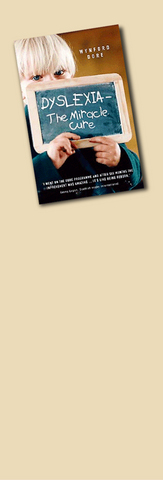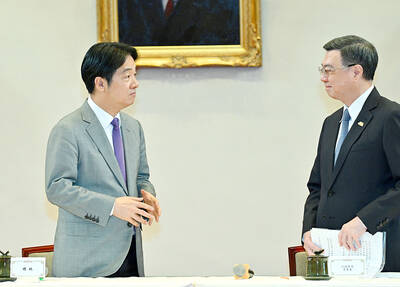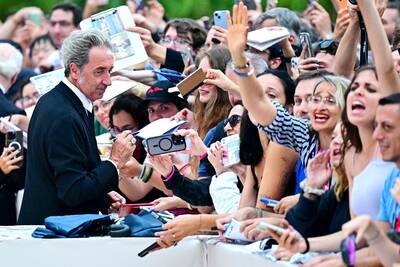Spin around in a circle 10 times, then do it in reverse and sit on a big medicine ball. Is this difficult? Feeling sick? If the answers are yes it could be that your cerebellum isn't functioning as it should and as a result you may have problems reading this sentence.
The connection between a part of the brain thought to be primarily responsible for motor control and language processing is not a new one, but businessman Wynford Dore has made the most of it with the establishment of over 30 clinics around the world, including Taiwan, that treat dyslexia, dyspraxia, Asperger's syndrome and Attention Deficit Hyperactivity Disorder (ADHD).
Dore's book, Dyslexia — The Miracle Cure, is a reasonably straightforward account of those suffering from these problems, why they have them and what can be done about it. It is far from being an academic research paper, however, as there are also sections on the author's conversion to the cause of remedial educational and glowing testimonials from sports and show business personalities about the efficacy of Dore's patented treatments.

If we are to believe what Dore says, many of the world's problems can be cleared up by performing two sets of 10-minute exercises a day, like taichi-lite. Not only do children and adults with learning difficulties benefit, but also criminals remarkably become musicians, pass exams without revision and swear off crime forever. Social offenders become model citizens, even drug addicts can be saved.
Dore sensibly starts at the beginning. He says he did not do well at school but nevertheless made a fortune in flame-retardant paint and was looking forward to early retirement on his yacht in Spain. This idyll was shattered by the attempted suicide of his daughter, who was depressed because of learning difficulties. As a result he applied his formidable energy, assets and business methods to a solution.
The book, co-written with David Brookes, then sketches Dore's journey in search of a holy grail for the educationally challenged. To cut the story short, Dore's conclusion is "all learning difficulties are the result of the same neurological problem in the brain — caused by a delay in the development of the cerebellum," which he calls Cerebellar Developmental Delay (CDD).
He then develops a non-drug based "cure" for CDD with various professors and doctors. This involves testing the subject on a range of machines and computer programs to create a personalized training regime. Examples of the exercises include throwing a beanbag from hand to hand; hopping on one leg in a circle on one leg; and sitting upright on a chair, turning the head from side to side, while focusing on a chosen point. Progress is monitored every six weeks and the program takes around one year to 18 months to complete.
Dore claims a success rate as high as 90 percent, says there is 500 percent progress in comprehension, 300 percent reading progress, as well as benefits to the subject's social skills and self-confidence. He also insists the effects are long term. A miracle? At some point the relentless optimism is reminiscent of a fundamentalist convert, as Dore touts his method as a panacea for the world's ills. He is an unabashed salesman and preacher. His detractors add that he is actually a huckster selling snake oil and the evidence he provides is pseudo-scientific.
Dore is defensive when he talks about this inevitable backlash to his ideas. He is particularly irritated by accusations that he is profiting from this, though his centers are businesses and not charitable institutions. It sounds disingenuous when he claims that he has spent his millions on research but has not taken a salary in return. An initial assessment at the Dore Achievement Center in Taiwan is NT$15,000 and the entire program costs around NT$96,000, according to Dore franchise director Dan Tattersfield. Like Dore, "I don't expect this to ever be a money-making operation," he adds in a telephone interview when asked about the commercial aspect of the operation.
Toward the end of the book the pace slows as Dore gets bogged down in an account of his struggles with the world of science and "The Establishment." He is dismissive of peer reviews despite accepting the premise they are necessary. He is convinced by his own arguments and finds it difficult to accept anyone else's. When government ministers, educators and scientists rebuff him they are fools. When they accept what he says they have seen the light and are lauded. He talks about a paradigm shift as if it was a simple matter for everyone to believe what he says and compares anyone who doubts his word as members of the Flat-Earth Society.
The chapter "How This Program Might Make You into a Better Sportsman" is like the adverts in comics that promise, "A bigger body! A new you, in 30 days, or your money back!" Dore even provides a formula that calculates the number of "repetitions needed to learn a given skill if the area of the cerebellum responsible for learning that skill is not completely developed." He also reprises the benefits of his program in case we missed the point the first or second time round. Nothing is gained by these repetitions and the constant banging of his own drum becomes monotonous after a while.
Even so, Dyslexia — The Miracle Cure is an easy 275 pages to read and the testimonials can be flipped through, as they are formulaic. On a positive note this is a unique book in many ways because it is not just empty words. Dore is a man of action who has established clinics around the world, tried to convince education authorities to adopt his methods and help those who need it. He deserves applause for his efforts but scientific review and facts should ultimately be the arbiter of what he has achieved.
The Dore Achievement Center in Taiwan opened two years ago and has 500 graduates. See www.dore.com.tw for further details.

Under pressure, President William Lai (賴清德) has enacted his first cabinet reshuffle. Whether it will be enough to staunch the bleeding remains to be seen. Cabinet members in the Executive Yuan almost always end up as sacrificial lambs, especially those appointed early in a president’s term. When presidents are under pressure, the cabinet is reshuffled. This is not unique to any party or president; this is the custom. This is the case in many democracies, especially parliamentary ones. In Taiwan, constitutionally the president presides over the heads of the five branches of government, each of which is confusingly translated as “president”

Sept. 1 to Sept. 7 In 1899, Kozaburo Hirai became the first documented Japanese to wed a Taiwanese under colonial rule. The soldier was partly motivated by the government’s policy of assimilating the Taiwanese population through intermarriage. While his friends and family disapproved and even mocked him, the marriage endured. By 1930, when his story appeared in Tales of Virtuous Deeds in Taiwan, Hirai had settled in his wife’s rural Changhua hometown, farming the land and integrating into local society. Similarly, Aiko Fujii, who married into the prominent Wufeng Lin Family (霧峰林家) in 1927, quickly learned Hoklo (commonly known as Taiwanese) and

The Venice Film Festival kicked off with the world premiere of Paolo Sorrentino’s La Grazia Wednesday night on the Lido. The opening ceremony of the festival also saw Francis Ford Coppola presenting filmmaker Werner Herzog with a lifetime achievement prize. The 82nd edition of the glamorous international film festival is playing host to many Hollywood stars, including George Clooney, Julia Roberts and Dwayne Johnson, and famed auteurs, from Guillermo del Toro to Kathryn Bigelow, who all have films debuting over the next 10 days. The conflict in Gaza has also already been an everpresent topic both outside the festival’s walls, where

The low voter turnout for the referendum on Aug. 23 shows that many Taiwanese are apathetic about nuclear energy, but there are long-term energy stakes involved that the public needs to grasp Taiwan faces an energy trilemma: soaring AI-driven demand, pressure to cut carbon and reliance on fragile fuel imports. But the nuclear referendum on Aug. 23 showed how little this registered with voters, many of whom neither see the long game nor grasp the stakes. Volunteer referendum worker Vivian Chen (陳薇安) put it bluntly: “I’ve seen many people asking what they’re voting for when they arrive to vote. They cast their vote without even doing any research.” Imagine Taiwanese voters invited to a poker table. The bet looked simple — yes or no — yet most never showed. More than two-thirds of those